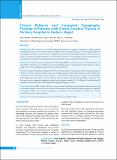Please use this identifier to cite or link to this item:
https://hdl.handle.net/20.500.14356/1434| Title: | Clinical Patterns and Computed Tomography Findings in Patients with Cranio-Cerebral Trauma in Tertiary Hospital in Eastern Nepal |
| Authors: | Adhikari, Kapil Gupta, Mukesh Kumar Pant, Ashok Raj Rauniyar, Raj Kumar |
| Citation: | AdhikariK., GuptaM. K., PantA. R., & RauniyarR. K. (2019). Clinical Patterns and Computed Tomography Findings in Patients with Cranio-Cerebral Trauma in Tertiary Hospital in Eastern Nepal. Journal of Nepal Health Research Council, 17(01), 56-60. https://doi.org/10.33314/jnhrc.v17i01.1269 |
| Issue Date: | 2019 |
| Publisher: | Nepal Health Research Council |
| Article Type: | Original Article |
| Keywords: | Computed tomography Cranio-cerebral trauma Road traffic accident |
| Series/Report no.: | Jan-March, 2019;1269 |
| Abstract: | Abstract Background: Head injury is a common problem encountered in emergency department. Among various neurological diseases, cranio-cerebral trauma ranks high in order of frequency and gravity. In acute setting, computed tomography is modality of choice because of its high accuracy in detecting intracranial lesions. The study was done to analyze computed tomography findings in cerebral trauma in regards to sociodemographic characteristics and find out associations of Computed tomography findings with mechanism of injury and clinical manifestations. Methods: The study was carried in Department of Radiology, BPKIHS, over a period of one year from Aug. 2015 to Aug. 2016. 450 patients were included in our study and findings noted on structured pro forma. Analysis was done using SPSS version 20 applying simple descriptive statistical methods. Results: Among 450 patients, 220 patients (48.9%) had various cranio-cerebral injuries. Most were in age group of 20-29 years (49.5%) and most common mode was road traffic accident (44.6%).Most patients presented with altered sensorium (39.2%) and Glasgow Coma Scale score of ?13 (70.9%). Scalp lesion was the most common finding (24%) followed by bone fractures (19.8 %). Patients with road traffic accident (59.7%) and fall from height (46.7%) had more positive computed tomography findings than from physical assault (28.2%). Glasgow Coma Scale showed significant statistical association with computed tomography findings (p<0.001). Conclusions: Road traffic accident is the most common mode of head injury in young adults patients presenting in our hospital. Glasgow Coma Scale can be considered as an important clinical marker for predicting positive computed tomography findings. Also computed tomography is an important initial investigation to evaluate the various craniocerebral injury in trauma patients. Keywords: Computed tomography; Cranio-cerebral trauma; road traffic accident. |
| Description: | Original Article |
| URI: | http://103.69.126.140:8080/handle/20.500.14356/1434 |
| ISSN: | Print ISSN: 1727-5482; Online ISSN: 1999-6217 |
| Appears in Collections: | Vol. 17 No. 1 Issue 42 Jan - Mar 2019 |
Files in This Item:
| File | Description | Size | Format | |
|---|---|---|---|---|
| 1269-Manuscript-9270-2-10-20190430.pdf | Fulltext Download | 217.4 kB | Adobe PDF |  View/Open |
Items in DSpace are protected by copyright, with all rights reserved, unless otherwise indicated.
